
Modernization
Learn more about government’s intention to modernize the museum to protect our historic holdings and provide better access to our collections.

Heidi Gartner, MSc, Previous Invertebrates Collection Manager and Researcher
Bryozoans, or “moss animals”, are colonial animals, meaning there are many repeating and connected individuals. They are suspension feeders, plucking food particles from the surrounding water with a specialized structure called a lophophore. Bryozoans grow on solid substrates such as shells, rocks and algae and are common components of benthic (ocean floor) communities. They are prey items for many micropredators (such as worms, small crustaceans and small gastropods) and, as bio-constructors, they can increase the available habitat and diversity for an area.
Bryozoans are a relatively understudied phylum, particularly in BC. They have no direct economic value, and they are generally small, cryptic and hard to identify without the use of a microscope. The goal of this project is to document bryozoan biodiversity in BC. This process will involve examining the Royal BC Museum collection and published records, working with key collaborators and doing fieldwork along the coast of BC. The outcome will be a report on the species of bryozoans in BC, new species descriptions, updated distribution data for invasive species, resolution of phylogenetic relationships within the phylum and increased content for museum outreach programs.
Currently, the project is focused on inventorying the museum bryozoan collection records and reviewing published literature related to bryozoans in BC. In the future, fieldwork will be conducted in remote marine areas along the central coast of BC. This is an underrepresented geographic area as well in the museum collection.
Forthcoming anticipated outputs include